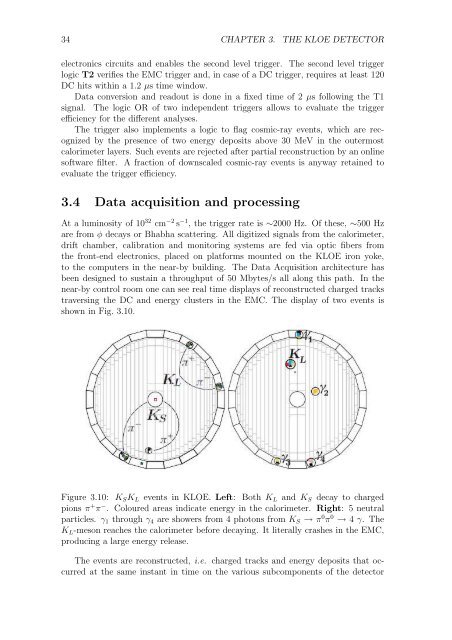Universit`a degli studi Roma Tre Measurement of the KL meson ...
Universit`a degli studi Roma Tre Measurement of the KL meson ...
Universit`a degli studi Roma Tre Measurement of the KL meson ...
Create successful ePaper yourself
Turn your PDF publications into a flip-book with our unique Google optimized e-Paper software.
34 CHAPTER 3. THE <strong>KL</strong>OE DETECTOR<br />
electronics circuits and enables <strong>the</strong> second level trigger. The second level trigger<br />
logic T2 verifies <strong>the</strong> EMC trigger and, in case <strong>of</strong> a DC trigger, requires at least 120<br />
DC hits within a 1.2 µs time window.<br />
Data conversion and readout is done in a fixed time <strong>of</strong> 2 µs following <strong>the</strong> T1<br />
signal. The logic OR <strong>of</strong> two independent triggers allows to evaluate <strong>the</strong> trigger<br />
efficiency for <strong>the</strong> different analyses.<br />
The trigger also implements a logic to flag cosmic-ray events, which are recognized<br />
by <strong>the</strong> presence <strong>of</strong> two energy deposits above 30 MeV in <strong>the</strong> outermost<br />
calorimeter layers. Such events are rejected after partial reconstruction by an online<br />
s<strong>of</strong>tware filter. A fraction <strong>of</strong> downscaled cosmic-ray events is anyway retained to<br />
evaluate <strong>the</strong> trigger efficiency.<br />
3.4 Data acquisition and processing<br />
At a luminosity <strong>of</strong> 10 32 cm −2 s −1 , <strong>the</strong> trigger rate is ∼2000 Hz. Of <strong>the</strong>se, ∼500 Hz<br />
are from φ decays or Bhabha scattering. All digitized signals from <strong>the</strong> calorimeter,<br />
drift chamber, calibration and monitoring systems are fed via optic fibers from<br />
<strong>the</strong> front-end electronics, placed on platforms mounted on <strong>the</strong> <strong>KL</strong>OE iron yoke,<br />
to <strong>the</strong> computers in <strong>the</strong> near-by building. The Data Acquisition architecture has<br />
been designed to sustain a throughput <strong>of</strong> 50 Mbytes/s all along this path. In <strong>the</strong><br />
near-by control room one can see real time displays <strong>of</strong> reconstructed charged tracks<br />
traversing <strong>the</strong> DC and energy clusters in <strong>the</strong> EMC. The display <strong>of</strong> two events is<br />
shown in Fig. 3.10.<br />
Figure 3.10: KS<strong>KL</strong> events in <strong>KL</strong>OE. Left: Both <strong>KL</strong> and KS decay to charged<br />
pions π + π − . Coloured areas indicate energy in <strong>the</strong> calorimeter. Right: 5 neutral<br />
particles. γ1 through γ4 are showers from 4 photons from KS → π 0 π 0 → 4 γ. The<br />
<strong>KL</strong>-<strong>meson</strong> reaches <strong>the</strong> calorimeter before decaying. It literally crashes in <strong>the</strong> EMC,<br />
producing a large energy release.<br />
The events are reconstructed, i.e. charged tracks and energy deposits that occurred<br />
at <strong>the</strong> same instant in time on <strong>the</strong> various subcomponents <strong>of</strong> <strong>the</strong> detector
















